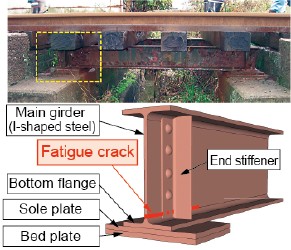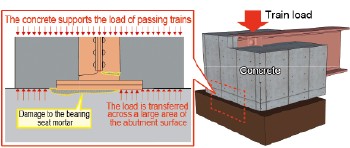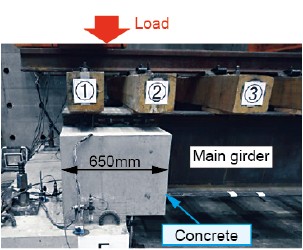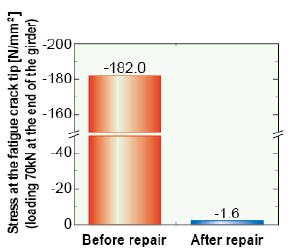14.Countermeasure for fatigue cracks around I-beam bridge supports
I-beam bridges are short span bridges built with small-section I-shaped steel beams, and often suffer fatigue cracks around the bridge supports (Fig 1).
It is difficult to patch the beams with repair plates over the fatigue cracks since crack initiation is located in transition area between the bottom flange and the web of the bridge support. Since no other effective countermeasure to this problem existed until now, this type of damage often led to the replacement of the bridge. Therefore, to solve this problem a new repair method has been developed whereby the end of the girder is covered with concrete (Fig. 2).
The method can prevent the fatigue crack propagation because the stress around the crack is drastically reduced by the concrete which supports the train load (Fig. 3 and 4).
This method was developed for small-section structures, and is applicable for most I-beam bridges that have a girder length of less than 7 m.
Fatigue cracking is caused by damage to the bearing seat mortar (Fig. 2), so existing methods require large scale work such as girder jacking to repair the bearing seat mortar. With this new method, it is not necessary to repair the bearing seat mortar, nor is it necessary to jack the girders. Repairs using the new method can be conducted fairly rapidly and reduce the costs by one third compared to bridge replacement.
Other Contents
- 13.Sheet pile reinforcement work on pile foundations during ground liquefaction
- 14.Countermeasure for fatigue cracks around I-beam bridge supports
- 15.Countermeasure work on ballasted Shinkansen track to prevent ballast migration
- 16.Method for detecting damage and repairing slab track cement asphalt mortar layers
- 17.Decision-making support system for planning replacement of wooden-sleepers with PC sleepers in curved sections
- 18.System for inspecting obstruction warning signals
- 19.Possibility of practical application of a 920MHz bandwidth network
- 13.Sheet pile reinforcement work on pile foundations during ground liquefaction
- 14.Countermeasure for fatigue cracks around I-beam bridge supports
- 15.Countermeasure work on ballasted Shinkansen track to prevent ballast migration
- 16.Method for detecting damage and repairing slab track cement asphalt mortar layers
- 17.Decision-making support system for planning replacement of wooden-sleepers with PC sleepers in curved sections
- 18.System for inspecting obstruction warning signals
- 19.Possibility of practical application of a 920MHz bandwidth network




